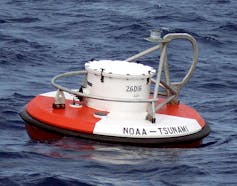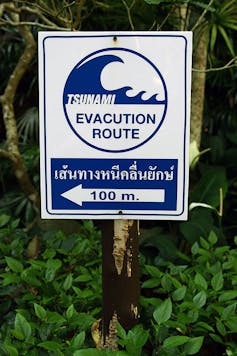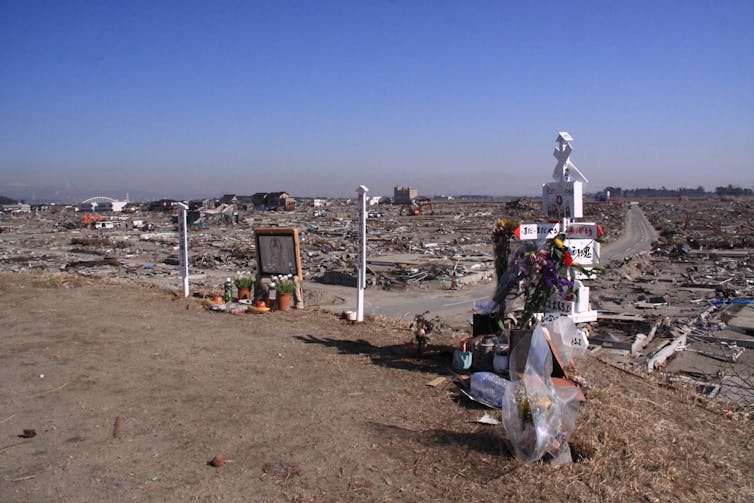How Likely Is It for a Tsunami Like the Boxing Day Tsunami to Occur Again
Ten years ago we witnessed one of the worst natural disasters in history, when a huge convulsion off the coast of Sumatra triggered a devastating tsunami which swept across the Indian Ocean.
An estimated 230,000 people lost their lives, and i.vi 1000000 people lost their homes or livelihoods.
The impact was greatest in northern Sumatra considering of its proximity to the convulsion. Catastrophic shaking was followed within minutes by the full force of the tsunami.
Avoidable deaths
Thousands of people were also killed in distant countries, where the convulsion could not exist felt. If they had received a alert of the approaching tsunami, they could accept moved inland, uphill or out to sea, and survived. Tsunami take several hours to cross an ocean, becoming much larger and slower as they reach the coast.
Dorsum in 2004 there were long-established tsunami warning systems in the Pacific Body of water, which has many subduction zones – places where two tectonic plates collide – capable of generating huge earthquakes or volcanic eruptions.
Other regions, including the Indian Ocean, did not have a alarm organization. The probability of a major tsunami was judged to be too low to justify the cost, especially for poorer countries.
The Boxing Day 2004 disaster changed all that.
Progress in the by decade
In early 2005, the UN agreed to develop an international warning system including regional systems in the Indian Bounding main, North Due east Atlantic & Mediterranean, and Caribbean. The Indian Ocean seismic sea wave warning system was developed between 2006 and 2013, at a total toll of at least $19 million.

In the three years prior to October 2014, bulletins were issued about 23 Indian Ocean earthquakes, resulting in a small number of potentially life-saving coastal evacuations. Most of these 23 earthquakes did non actually generate a threatening tsunami because they did non cause significant uplift or subsidence of the seafloor. But false alarms can provide reassurance that communications work well, or highlight weaknesses.
Communications and evacuation procedures are also regularly tested by international mock drills, often based on worst example scenarios.
How do seismic sea wave warning systems piece of work?
All alarm systems work in the same full general way. First, a network of broadband seismometers detects the seismic waves generated by an earthquake, which travel at speeds of several kilometres per second. When several seismometers have detected the seismic waves, the location and gauge magnitude of the earthquake tin be computed. If the epicentre is under h2o and the magnitude large (greater than half dozen.5 on the Richter, or moment magnitude, scale) a seismic sea wave bulletin, watch or warning is issued to local communication centres, ideally inside three minutes of the earthquake. If the epicentre is nearby and the probability of a tsunami is high, evacuation procedures volition be initiated immediately.

Otherwise, local centres will standby for confirmation of whether a seismic sea wave has actually been generated. Confirmation comes within virtually thirty-60 minutes, using a network of tsunami buoys and seafloor force per unit area recorders. These detect the serial of waves (usually less than a couple of metres loftier and travelling at about 800 km/h) in the open up ocean, and transmit the information by satellite to a regional command centre.
Tsunami warnings reach the public via Television set, radio, electronic mail, text messages, sirens and loudspeakers. Y'all tin sign upwards to receive seismic sea wave alerts anywhere in the world past SMS on your mobile phone, thanks to a not-for-profit humanitarian service called CWarn.org.
Many high-risk areas as well take signage to alert people to "natural" warnings (such as strong shaking or a sudden withdrawal of the ocean), and direct them to higher ground.
Limitations of warning systems
The Pacific and Japanese warning systems helped to ensure the major seismic sea wave generated off the coast of Japan on xi March 2011 caused far fewer deaths (15,000) than the 2004 disaster. Even so, it showed that even a wealthy and well-prepared nation such as Nippon cannot fully protect people from extreme hazards, and that warning systems tin sometimes lead to a false sense of security.

The tiresome rupture of the subduction zone near Nihon meant the initial warnings underestimated the magnitude of the earthquake and resulting tsunami. Many people did not move to higher footing in the vital few minutes afterwards receiving the warning, because they wrongly causeless the seismic sea wave would be stopped past five-10 k high sea walls.
Japan has learned from this tragedy and, amongst other things, made changes to seismic sea wave warning messages, improved coastal defences, and installed more seismometers and tsunami buoys.
Will more tsunami disasters occur?
Information technology is impossible to predict exactly when or where the next major tsunami volition occur. They are very rare events in our limited historical record. But by dating prehistoric tsunami deposits, we can see that major tsunamis happen on average every few hundred years in many coastal regions.
Time to come tsunami disasters are inevitable, but with ameliorate technology, education and governance we tin realistically hope that a loss of life on the scale of the 2004 seismic sea wave disaster will not happen again.
Source: https://theconversation.com/ten-years-after-the-boxing-day-tsunami-are-coasts-any-safer-35099
Post a Comment for "How Likely Is It for a Tsunami Like the Boxing Day Tsunami to Occur Again"